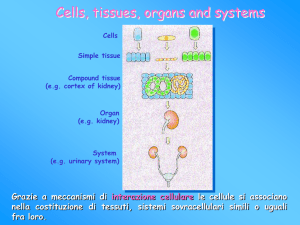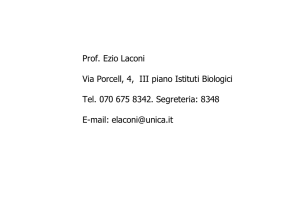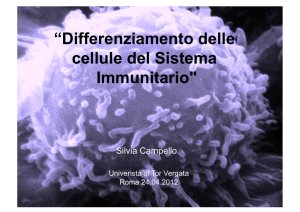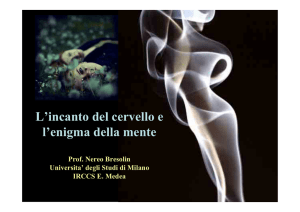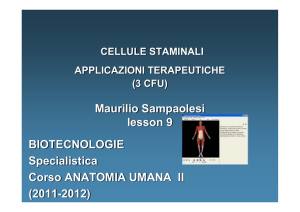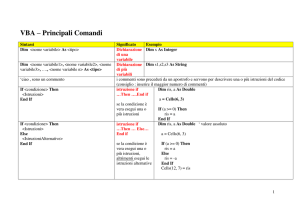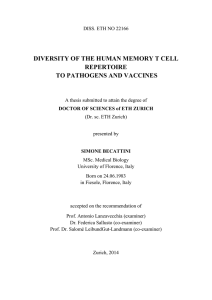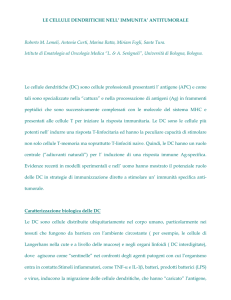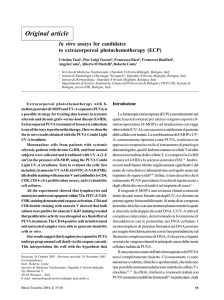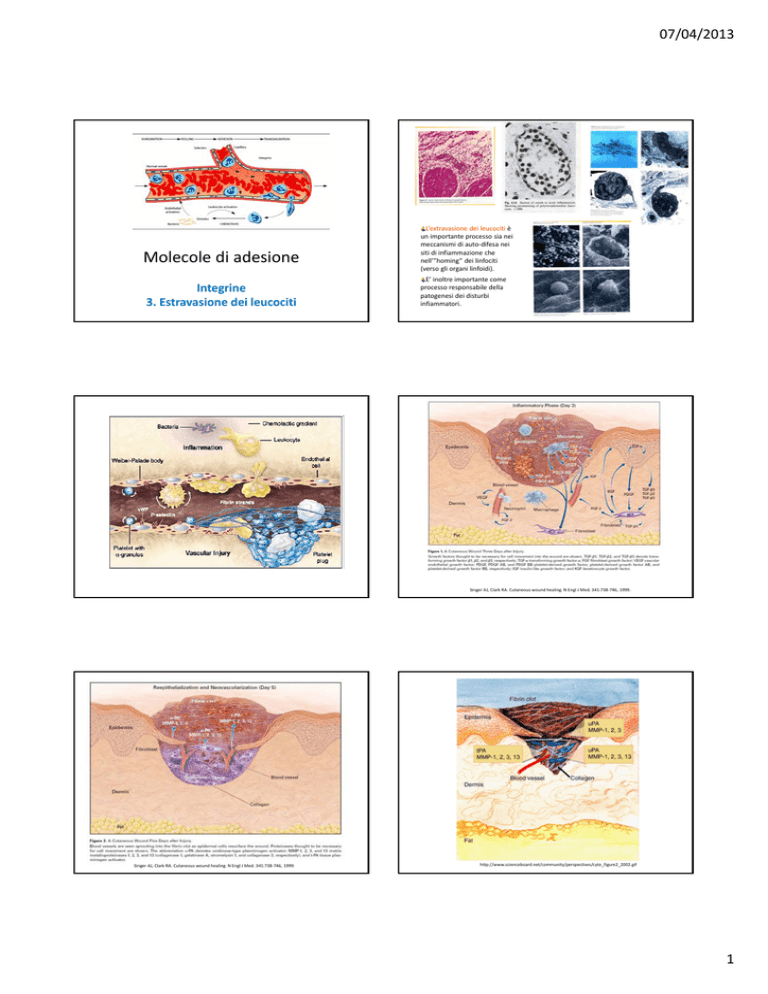
07/04/2013
Molecole di adesione
Integrine
3. Estravasione dei leucociti
L’extravasione dei leucociti è un importante processo sia nei meccanismi di auto‐difesa nei siti di infiammazione che nell’”homing” dei linfociti (verso gli organi linfoidi).
E’ inoltre importante come processo responsabile della patogenesi dei disturbi infiammatori.
Singer AJ, Clark RA. Cutaneous wound healing. N Engl J Med. 341:738‐746, 1999.
Singer AJ, Clark RA. Cutaneous wound healing. N Engl J Med. 341:738‐746, 1999.
http://www.scienceboard.net/community/perspectives/cyto_figure2_2002.gif
1
07/04/2013
RUOLO DEI CARBOIDRATI
Ruolo più noto: Il carboidrato è una delle molecole complementari
riconosciute dalla famiglia proteica delle “selettine”, espresse sulle cellule
endoteliali quando i leucociti migrano verso i siti di infiammazione o sui linfociti o
quando i linfociti maturi circolano fra la circolazione sanguigna e la circolazione
linfatica.
Integrin switching helps mediate keratinocyte migration across wounded skin. In this graphic representation, keratinocytes are depicted as ovals containing the major integrin subunits they express, and the extracellular matrix is depicted as elongated brown cylinders. Intact keratinocytes bound to basement membrane are shown on the left and migrating keratinocytes at the wound edge are shown on the right. Matrix metalloproteases (MMPs) enable migration by breaking down the underlying basal lamina at the leading edge of the keratinocyte sheet, where the cells assume a flattened shape and express an array of integrins that permits migration across the newly formed granulation tissue. The leading epithelial cells rearrange their distribution of b1 integrins to engage with type I collagen below the damaged/absent basement membrane. Lo svantaggio dei carboidrati espressi sulla superficie cellulare è che le cellule che rivestono la trachea, stomaco o intestino aprono una strada che permette ai microorganismi e ai virus di invadere le cellule.
Leukocytes roll on stimulated endothelium before migrating to sites of inflammation or vascular injury. This initial and essential step is largely mediated by the selectins and their ligands. The leukocyte receptors involved cluster on small membrane projections (microvilli). Schultz et al: Dynamic reciprocity in the wound microenvironment. Wound Repair Regen. 19:134‐148, 2011.
2
07/04/2013
Ancoraggio dei leucociti circolanti all’endotelio attivato
mediante interazioni fra selettine e i loro ligandi
(a) Nelle venule normali i leucociti fluiscono senza interazioni adesive con l’endotelio, ma nei vasi
infiammati, vengono espresse sulla superfice delle cellule endoteliali selettine e ligandi per le integrine.
Questo porta all’ancoraggio, rottolamento (“rolling”), e arresto dei leucociti circolanti e la loro finale
estravasione dalla circolazione verso il tessuto circostante. Ad esempio, la P-selettina è normalmente
espressa nei corpi di Weibel-Palade delle cellule endoteliali, ma entro pochi minuti dopo l’attivazione delle
cellule endoteliali mediante trombina, istamina, ipossia o danno, questi corpi si fondono con la membrana
plasmatica, promuovendo l’espressione della P-selettina sulla superficie della cellula endoteliale. Allo stesso
modo, la P-selettina immagazzinata nei granuli α delle piastrine viene espressa sulla superficie delle
piastrine pochi minuti dopo l’attivazione piastrinica. I leucociti si ancorano e rottolano sulle cellule endoteliali
attivate e le piastrine.
Selectins, ICAMs, and integrins mediate leukocyte-endothelial cell
adhesion near sites of infection
http://www.ncbi.nlm.nih.gov/books/NBK21599/figure/A6507/?report=objectonly
http://www.nature.com/nri/journal/v7/n9/images/nri2156‐f3.jpg
3
07/04/2013
The Adhesion Cascade
Circulating cells can detect release of chemokines at a site of injury using chemokine
receptors on their surface. They follow the concentration-gradient of released chemokines
towards the highest concentration. This is present at the actual site of chemokine release i.e
the site of injury. In order cells to enter to the inflamed tissues they need to cross the vascular
endothelium. To do that, leukocytes first tether to, roll along, adhere to and pass between
the endothelial cells of blood vessels, a process known as the adhesion cascade
Capture
P-selectin on endothelial cells, is the primary adhesion molecule for capture and the initiation of
rolling. The main leukocyte ligand for P-selectin is PSGL-1 (P-selectin glycoprotein ligand 1).
Rolling
P-selectin is the most important selectin involved in leukocyte rolling. During rolling, bonds are
formed at the leading edge of the rolling cell and broken at the trailing edge.
Slow Rolling
E-selectin on the endothelium is known to be an important mediator of slow rolling.
Postcapillary
venule
Progressive Activation
Capture Rolling
Slow
Rollin
g
Firm
Adhesio
n
Firm Adhesion
Integrins such as CD18 (β2 integrin) on neutrophils and VLA-4 (β1 integrin) on eosinophils and
monocytes are important in adhesion. Members of the immunoglobulin superfamily such as ICAM-1
and VCAM-1 are expressed on endothelial cells and interact with the integrins.
Transmigration
Transmigration
CD31 (PECAM-1) on endothelial cells and αvβ3 or CD31 on leukocytes interact to mediate migration
of leukocytes out of the vessels and into the interstitium.
Transinterstitial Migration
SELECTINS
INTEGRINS
CD29 (β1 integrins) on leukocytes interact with RGD sequences present on extracellular matrix
proteins (fibronectin, collagen, laminin) in the interstitium.
Chemoattractant
Durante lo sviluppo dell’embrione del topo si osserva una notevole
alterazione dell’espressione di antigeni di superficie, che sono soprattutto
carboidrati. Il trattamento degli embrioni con zuccheri aptenici, con inibitori biosintetici delle glicosiltrasferasi
o con glicosidasi di processamento ha provocato l’arresto dello sviluppo in certi stadi, suggerendo che gli antigeni
carboidrati sono essenziali, probabilmente a causa del loro coinvolgimento nelle interazioni cellulari. A favore di
questa ipotesi, è stata identificata uma molecola di tipo lectina nelle cellule dell’embrione di rana nella fase di
segmentazione.
Nelle cellule tumorali è stata osservata un’alterata glicosilazione delle
proteine di superficie, che è coinvolta nei processi di metastatizzazione.
T cell–endothelial-cell interactions as
studied in flow chamber systems in vitro.
P-selectin-dependent interactions require
functional P-selectin glycoprotein ligand 1
(PSGL1); E-selectin interactions require
poorly defined E-selectin ligand(s) on
activated T cells. L-selectin on T cells
interacts with peripheral node addressin
(PNAD). At sites of inflammation,
endothelial cells express P- and Eselectin and during chronic inflammation
PNAD is also expressed by endothelial
cells. b | At sites of inflammation,
neutrophils and monocytes, or neutrophilor monocyte-derived microparticles,
interact with the inflamed endothelium
and present functional PSGL1 to T cells.
This PSGL1 can interact with L-selectin
on naive or central memory T cells.
Activated platelets and platelet-derived
microparticles are also known to interact
with the vascular endothelium and can
present P-selectin to T cells. Note that for
simplicity, not all domains of the selectins
are depicted, although they are
represented according to their relative
sizes.
Selectins in T-cell recruitment to non-lymphoid
tissues and sites of inflammation
Klaus Ley and Geoffrey S. Kansas
Nature Reviews Immunology 4, 325-336 (May
2004)
4


